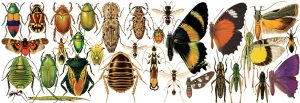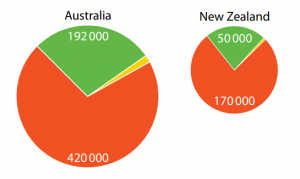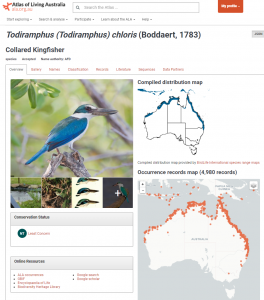
The main function of the ALA is to enable users to access, visualise and analyse biodiversity data (predominantly occurrence records – where plants and animals are). In order to do this, the ALA needs authoritative reference lists and resources to provide context to the data, and to enable users to search, filter, analyse and visualise the data.
The most obvious reference information critical to the ALA is naming and taxonomy data.

Names and classification: science fundamentals
The science of naming and classifying species (taxonomy) is dynamic and constantly changing. Only 30 per cent of the estimated 830,000 species in Australia and New Zealand have been described and named.
Call in the experts: Australia’s authorities on species names and classifications
The ALA uses a variety of authoritative lists for Australian taxa and these are used to build the names and taxonomic hierarchy applied to all occurrence records supplied to the ALA. The species name that data providers give to the ALA in occurrence records (supplied name) is matched to these lists and becomes the name (processed name) by which the record is displayed, matched and synthesised. This is so the vast amount of data supplied to the ALA can be aggregated and presented in a consistent and meaningful way.
These lists are built and maintained on behalf of the community by a number of key players that maintain the names and taxonomy of Australian flora and fauna; these are the Australian Biological Resources Study (ABRS) working with the member institutions of the Council of Heads of Australasian Herbaria (CHAH) and Council of Heads of Australian Faunal Collections (CHAFC) to provide national leadership for the discovery, naming and classification of Australia’s living organisms. It is their role to keep up to date with changes in taxonomy. The primary sources of name and taxonomic resources for Australian species come from the:
- Australian Faunal Directory (AFD) which provides the ALA with names and taxonomy for Australian fauna
- Australian Plant Name Index (APNI) and Australian Plant Census (APC) for Australian vascular plants
- AusFungi and AusMoss for fungi and mosses respectively.
The scope of these resources focuses on organisms found in Australia and surrounding waters, however as the ALA also includes occurrence records for organisms found in New Zealand, Antarctica, the South Pacific and many other places it also needs to incorporate other sources. Recently the New Zealand Organism Register has been included in this list.
Conservation lists
Each state and territory government, as well as the federal government and international bodies, maintain conservation species lists. The classifications within the lists are based on the categories provided by the International Union for Conservation of Nature ranging from Least Concern, Near Threatened and Vulnerable through to Critically Endangered and Extinct, but there are some variations to category names in each state and territory. Each state and territory is responsible for providing up-to-date conservation information.

Spatial and environmental layers
In addition to names, taxonomy and conservation information, the ALA also needs authoritative reference lists for the environmental layers and geospatial mapping information used to visualise and interrogate data.
Spatial information such as geospatial references, specific boundaries of environmental protected areas, and state and territory boundaries enable ALA users to look at what species live in particularly defined areas. A key provider of this type of information is the Australian Government Department of the Environment and Energy.
Access to environment information, such as humidity, temperature and rainfall figures, enables ALA users to interrogate species occurrences by these environmental factors. For example, which species only occur in high rainfall areas, or alpine areas with high altitude, cold climate and complex topography. Two key providers of environmental information are Geoscience Australia and Australian Bureau of Agricultural and Resource Economics and Sciences (ABARES).
Species occurrence records
The ALA’s bread and butter is the 78.5 million (and growing) occurrence records. This information is provided by collections institutions (including museums and herbaria), government departments, researchers, community groups and individuals.
A few key players in each of the groups that provide occurrence records data to the ALA, include:
- the Australasian Virtual Herbarium (AVH) which provides access to 6.8 million records from herbaria in all Australian states and territories and New Zealand
- the Online Zoological Collections of Australian Museums (OZCAM) aggregates 5.1 million records from all Australian states and territories, plus the CSIRO National Collections
- BioNet, the Atlas of NSW Wildlife, contributes over 10 million records
- Bird Life Australia, Australia’s largest bird conservation organisation, has uploaded 13.6 million individual records
- a total of 84, 395 individual sightings have been uploaded directly to the ALA by citizen scientists; to view these, visit Recent sightings.
ALA is the tip of the iceberg
Hopefully this brief summary of the ALA’s data providers sheds some light on the amount of information accessible via the ALA, and importantly explains that the ALA is a mere window into the vast, complex world of biodiversity science. The work of the organisations and institutions that provide data, and manage, curate and update that data, is fundamental to the success of the ALA.
This is an ode to our data providers – essentially, without them we’re nothing.
For more information, please view:
- Australia’s Natural History Collections on the ALA
- Occurrence record search on the ALA